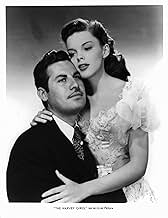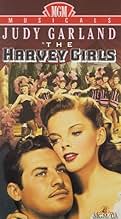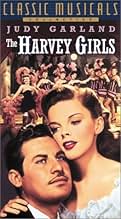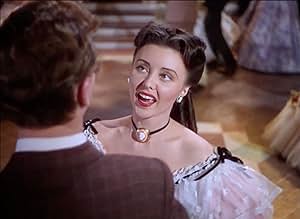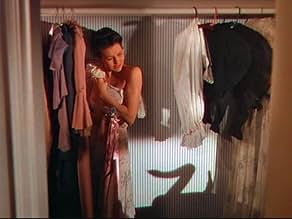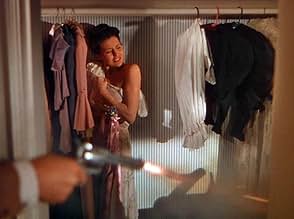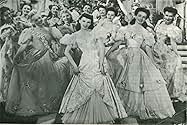IMDb-BEWERTUNG
7,0/10
5186
IHRE BEWERTUNG
Füge eine Handlung in deiner Sprache hinzuOn a train trip West to become a mail-order bride, Susan Bradley meets a cheery crew of young women travelling out to open a "Harvey House" restaurant at a remote whistle-stop.On a train trip West to become a mail-order bride, Susan Bradley meets a cheery crew of young women travelling out to open a "Harvey House" restaurant at a remote whistle-stop.On a train trip West to become a mail-order bride, Susan Bradley meets a cheery crew of young women travelling out to open a "Harvey House" restaurant at a remote whistle-stop.
- 1 Oscar gewonnen
- 4 Gewinne & 1 Nominierung insgesamt
William 'Bill' Phillips
- 1st Cowboy
- (as Wm. 'Bill' Phillips)
Empfohlene Bewertungen
The first person you see is Judy Garland singing an infinitely forgettable song.
For the most part it goes up from there.
This is a film that Vincente Minelly did not direct and even though it shows Judy at her demure best he had a knack for bringing out the best in her performances.
Surprisingly enough, this is not an entirely inaccurate history of the women that opened up the West -- just as much as the men did.
For those that do not know -- Fred Harvey was a railroad tycoon and visionary that realized that the United States could only expand Westward -- and he was there to help fulfill that dream.
His chain of "Railroad Hotels" (some of which still exist) and the women that staffed them, helped to civilize parts of the United States that were raw and uncultured.
This is one of those incredible films that has every face you have ever seen in a movie -- even if you do not always know their names: Ray Bolger, Preston Foster, Virginia O'Brien, John Hodiak, Angela Lansbury, Marjorie Main, Chill Wills and even Cyd Charisse.
This is cameo paradise and there is a character and face there for everyone.
The songs, the costumes, the sets and everything BUT the dialogue and story are top notch. But who needs a good script when you have a cast of STARS! (Especially Judy Garland.)
Take the good parts from this movie and try to pretend the rest never happened.
For the most part it goes up from there.
This is a film that Vincente Minelly did not direct and even though it shows Judy at her demure best he had a knack for bringing out the best in her performances.
Surprisingly enough, this is not an entirely inaccurate history of the women that opened up the West -- just as much as the men did.
For those that do not know -- Fred Harvey was a railroad tycoon and visionary that realized that the United States could only expand Westward -- and he was there to help fulfill that dream.
His chain of "Railroad Hotels" (some of which still exist) and the women that staffed them, helped to civilize parts of the United States that were raw and uncultured.
This is one of those incredible films that has every face you have ever seen in a movie -- even if you do not always know their names: Ray Bolger, Preston Foster, Virginia O'Brien, John Hodiak, Angela Lansbury, Marjorie Main, Chill Wills and even Cyd Charisse.
This is cameo paradise and there is a character and face there for everyone.
The songs, the costumes, the sets and everything BUT the dialogue and story are top notch. But who needs a good script when you have a cast of STARS! (Especially Judy Garland.)
Take the good parts from this movie and try to pretend the rest never happened.
With Broadway still under the spell of musicals like "Oklahoma", MGM's Arthur Freed was inspired to make a western musical. Originally designed for Lana Turner, the script was altered and songs added to make it a perfect vehicle for Judy Garland. The songs by Johnny Mercer and Harry Warren included two standouts: "On the Atchison, Topeka and the Santa Fe" and "It's A Great Big World".
Judy gives an inspired performance and belts out her songs with gusto, particularly effective in the big set piece, "Atchison", which is photographed and choreographed with great precision to produce a dazzling show-stopping number. The film opened to great reviews and was a big box-office hit in the summer of '46.
Don't believe the "sour grapes" reviews claiming the film is dated and mediocre. It's anything but that. If you enjoy MGM musicals at the height of their popularity with film-goers, you'll enjoy this one! Marjorie Main is a treat, Selena Royle is dignified, Kenny Baker does wonders with a ballad and Cyd Charisse has a couple of nice numbers. It's nice to see Ray Bolger sharing scenes with Judy again, their first reunion since "Oz". The big surprise is Angela Lansbury as the garishly costumed dancehall hostess--a far cry from her "Murder She Wrote" image.
Understandably, "On the Atchison, Topeka and the Santa Fe" won the Academy Award for Best Song, as well as a nomination for Best Scoring of a dramatic or comedy film.
Judy gives an inspired performance and belts out her songs with gusto, particularly effective in the big set piece, "Atchison", which is photographed and choreographed with great precision to produce a dazzling show-stopping number. The film opened to great reviews and was a big box-office hit in the summer of '46.
Don't believe the "sour grapes" reviews claiming the film is dated and mediocre. It's anything but that. If you enjoy MGM musicals at the height of their popularity with film-goers, you'll enjoy this one! Marjorie Main is a treat, Selena Royle is dignified, Kenny Baker does wonders with a ballad and Cyd Charisse has a couple of nice numbers. It's nice to see Ray Bolger sharing scenes with Judy again, their first reunion since "Oz". The big surprise is Angela Lansbury as the garishly costumed dancehall hostess--a far cry from her "Murder She Wrote" image.
Understandably, "On the Atchison, Topeka and the Santa Fe" won the Academy Award for Best Song, as well as a nomination for Best Scoring of a dramatic or comedy film.
The Harvey Girls, a film to celebrate the first of the fast food chains which quite frankly would be what the Harvey Restaurant chain was back in the modernizing west. There are folks in the town who don't want to see the Harvey Restaurant established and thereby hangs the tale of this film.
Preston Foster is the town boss and John Hodiak runs the saloon. These guys thrive on the town being in the Wild West accent on the wild. Foster's a rather shrewd villain, he realizes that the clean cut virginal Harvey girls who are servers might make the men forget the loose women of the saloon and that if they court and marry them and start raising families, they might demand a little law and order. That would be a disaster for Foster. Better to cut the problem off at the root.
Hodiak however is a jaded sort and bored with the loose women of his establishment. In a cinema not under the Code influence, Angela Lansbury and her crew would be prostitutes. He kind of likes the idea of the Harvey Restaurant coming to town and likes it better when Judy Garland comes to town.
Judy's come to town as a mail order bride, but when she sees Chill Wills is the prospective groom, both of them decide they're not suited for each other. Hodiak has been writing Wills's letters, a plot device that was used in the Joseph Cotten-Jennifer Jones film Love Letters. If you know about that film, you know how The Harvey Girls turns out.
The Harvey Girls has come down in cinema history because of the famous On The Atchison, Topeka, And The Santa Fe number. The song itself won an Academy Award in 1946 for best original song and the number as staged by MGM is one of the longest and most complex in the annals of film. It runs about 20 minutes and just about every member of the cast except Hodiak and Foster get a line or two in the song. Of course it ends with Judy as well it should have.
One thing I don't understand though is the under use of both Ray Bolger and Kenny Baker. Bolger of course had co-starred with Judy in The Wizard Of Oz, but he was far more known for being a Broadway star than a film player. He had just come off a big run in the last Rodgers&Hart musical By Jupiter. Kenny Baker was a famous radio singer who also had starred on Broadway in Kurt Weill's One Touch Of Venus with Mary Martin. Why these guys got the supporting roles they did is a mystery to me. I suspect both of them had a lot of their parts end up on the cutting room floor.
MGM editing mastery was at its best in The Harvey Girls. The film was partially done on location and partially done at Culver City. The editing is so smooth you really can't tell.
Harry Warren and Johnny Mercer wrote the score for The Harvey Girls and while the Atchison number dwarfs the rest, there's a song called It's A Great Big World that gets sadly neglected. It was sung by Judy Garland, Virginia O'Brien, and someone dubbing Cyd Charisse who first got noticed in this film for her dancing.
As I said before if done today if some gazillionaire would finance a remake, Angela and her saloon girls would be portrayed more frankly as working girls. But that would also cause the film to lose some of its naive charm. And this film holds up quite well for 63 years and counting.
Preston Foster is the town boss and John Hodiak runs the saloon. These guys thrive on the town being in the Wild West accent on the wild. Foster's a rather shrewd villain, he realizes that the clean cut virginal Harvey girls who are servers might make the men forget the loose women of the saloon and that if they court and marry them and start raising families, they might demand a little law and order. That would be a disaster for Foster. Better to cut the problem off at the root.
Hodiak however is a jaded sort and bored with the loose women of his establishment. In a cinema not under the Code influence, Angela Lansbury and her crew would be prostitutes. He kind of likes the idea of the Harvey Restaurant coming to town and likes it better when Judy Garland comes to town.
Judy's come to town as a mail order bride, but when she sees Chill Wills is the prospective groom, both of them decide they're not suited for each other. Hodiak has been writing Wills's letters, a plot device that was used in the Joseph Cotten-Jennifer Jones film Love Letters. If you know about that film, you know how The Harvey Girls turns out.
The Harvey Girls has come down in cinema history because of the famous On The Atchison, Topeka, And The Santa Fe number. The song itself won an Academy Award in 1946 for best original song and the number as staged by MGM is one of the longest and most complex in the annals of film. It runs about 20 minutes and just about every member of the cast except Hodiak and Foster get a line or two in the song. Of course it ends with Judy as well it should have.
One thing I don't understand though is the under use of both Ray Bolger and Kenny Baker. Bolger of course had co-starred with Judy in The Wizard Of Oz, but he was far more known for being a Broadway star than a film player. He had just come off a big run in the last Rodgers&Hart musical By Jupiter. Kenny Baker was a famous radio singer who also had starred on Broadway in Kurt Weill's One Touch Of Venus with Mary Martin. Why these guys got the supporting roles they did is a mystery to me. I suspect both of them had a lot of their parts end up on the cutting room floor.
MGM editing mastery was at its best in The Harvey Girls. The film was partially done on location and partially done at Culver City. The editing is so smooth you really can't tell.
Harry Warren and Johnny Mercer wrote the score for The Harvey Girls and while the Atchison number dwarfs the rest, there's a song called It's A Great Big World that gets sadly neglected. It was sung by Judy Garland, Virginia O'Brien, and someone dubbing Cyd Charisse who first got noticed in this film for her dancing.
As I said before if done today if some gazillionaire would finance a remake, Angela and her saloon girls would be portrayed more frankly as working girls. But that would also cause the film to lose some of its naive charm. And this film holds up quite well for 63 years and counting.
This works quite well as light entertainment. It has a good cast, with Judy Garland giving a lively performance in the lead role. The setting is rather stylized, but it is interesting, and it provides some good story material. The story has quite a few amusing moments, with just enough substance to keep it moving. There is also the top-notch "Atchison, Topeka, & the Santa Fe" number, which would almost make a musical worth watching all by itself.
The story of the conflict between the "Harvey Girls" and their rivals across the road is sometimes a little exaggerated, but it is relatively interesting and it makes for some good sequences. The female cast members get most of the best moments, and they generally use them well. Angela Lansbury seems quite natural as Garland's disagreeable nemesis, Virginia O'Brien has some good lines, and Marjorie Main is quite lively. There's more than enough to make it an enjoyable, if light, feature.
The story of the conflict between the "Harvey Girls" and their rivals across the road is sometimes a little exaggerated, but it is relatively interesting and it makes for some good sequences. The female cast members get most of the best moments, and they generally use them well. Angela Lansbury seems quite natural as Garland's disagreeable nemesis, Virginia O'Brien has some good lines, and Marjorie Main is quite lively. There's more than enough to make it an enjoyable, if light, feature.
Very appealing MGM musical with wonderful songs, colorful production, Judy Garland at the peak of her feisty charms. In the burgeoning days of train transportation, women are needed to work the eateries scattered throughout the Southwest; in a small New Mexico town, Judy decides to ditch her mail-order marriage for a waitressing job, but she soon finds love again. "On The Atchinson, Topeka and The Santa Fe" won a Best Song Oscar, and deservedly so; this grand number gets the full treatment, and is so exuberantly staged it becomes a classic by itself. The picture does runs short of ideas and inspiration near the end, leading to a poorly-staged romantic finale, yet the supporting cast is excellent, particularly Angela Lansbury as a jealous showgirl. *** from ****
Wusstest du schon
- WissenswertesIn the big production number "On the Atchison, Topeka and the Santa Fe," from Judy Garland's entrance until the conductor's "All aboard!" was done in one take. Legend has it that they shot it twice and Garland was dead-on move for move both times.
- PatzerIn the "Wild, Wild West" song, Alma is pounding a red-hot horseshoe. She then picks it up, caresses it, and throws it in the water barrel where it gives off steam. The horseshoe would have burned her hand if it were really hot. This is a sight gag in the film.
- VerbindungenFeatured in MGM Parade: Folge #1.25 (1955)
- SoundtracksIn the Valley (Where the Evenin' Sun Goes Down)
(uncredited)
Music by Harry Warren
Lyrics by Johnny Mercer
Performed by Judy Garland
Top-Auswahl
Melde dich zum Bewerten an und greife auf die Watchlist für personalisierte Empfehlungen zu.
Details
Box Office
- Budget
- 2.524.315 $ (geschätzt)
- Weltweiter Bruttoertrag
- 1.417 $
- Laufzeit
- 1 Std. 42 Min.(102 min)
- Seitenverhältnis
- 1.37 : 1
Zu dieser Seite beitragen
Bearbeitung vorschlagen oder fehlenden Inhalt hinzufügen


